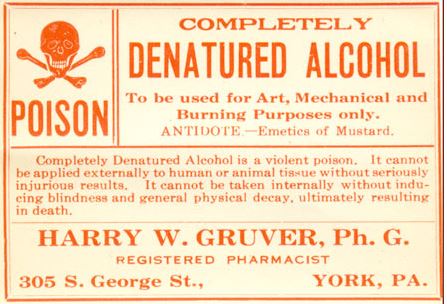Welcome back to another edition of STRANGE HISTORY! A few months ago we highlighted the vampire panic that struck a small Rhode Island town in the 1890s. Weird tales from real life make excellent fodder for creative nerdery, whether you’re building a world for your novel or creating your next D&D campaign.
Today we’ll investigate the intentional mass poisoning of alcohol by the American government during Prohibition that ended up killing an estimated 10,000 people. Too wild for fiction, too weird to possible be true, this is STRANGE HISTORY!
A Moral Crusade
To truly understand this story, you have to go back to 1830s-40s America. These were the years of the Second Great Awakening, a time when Christians, motivated by an intense desire to reform American society, focused on abolishing slavery, ending male-only suffrage, and getting every kid in school. One of the longest-lasting, popular, and widespread movements to emerge from the Second Great Awakening was the temperance movement.

Temperance groups were devoted to the elimination of alcohol from society. Their strategies varied to suit their audience. Some focused on personal reform, convincing people to become card-carrying members of huge temperance groups like the Anti-Saloon League. Other groups lobbied state and federal politicians, sponsored events like temperance picnics and plays, or funded temperance candidates running for public office.
By World War I, the movement was presented with the perfect set of conditions. The public was electrified by the United States’ entry into the Great War in 1917, and temperance groups (often anti-immigrant to begin with) played anti-German sentiment into political action. Many states and counties had already passed temperance laws by the 1910s, and well-connected temperance activists were able to pressure Congress and state governments into passing the Eighteenth Amendment in 1919.
Not A Drop To Drink
Temperance groups across America celebrated Prohibition when it went into effect on January 17, 1920. Supporters of the Eighteenth Amendment (called “dries”) were sure that outlawing the “manufacture, sale, or transportation of intoxicating liquors” would lead to the elimination of most if not all of society’s problems.
What these moral crusaders failed to recognize was something the COVID-19 pandemic is teaching us today: the government can’t legislate human behavior. People who drank alcohol didn’t stop wanting to drink when Prohibition went into effect. Illegal alcohol distilleries popped up across the country. Secret bars called speakeasies could be found in any sizable town or city with the right password.
Folks with money and connections kept their stash by paying rum-runners to smuggle illegal hooch. Criminal organizations like the Mafia, willing to break the law if it meant getting paid, flourished during the 1920s. This led to the curious public idolization of brutal gangsters like Al Capone, who were Robin Hood-esque figures for anti-Prohibition “wets”.
Hazardous Hooch
Determined to continue drinking but banned from obtaining it legally, many Americans bought homemade alcohol of suspect origin and quality. Moonshiners would steal industrial alcohol, either themselves or purchased from the gangs, distill the alcohol of poisons and impurities, and resale it as “drinkable” liquor. The chemical makeup of alcohol used in paints and fuel, combined with the self-taught skills of distillers, meant that anyone desperate enough to try homemade hooch during Prohibition was risking a likelihood of alcohol poisoning, if not death.

“Dries” were shocked that “wets” would defy federal law and risk death to continue drinking. By 1926, with illegally distilled liquor more popular than ever, the Treasury Department ordered industrial alcohol manufacturers to make their products so poisonous that no one would be able to distill (much less drink) them. Poisons like mercury salts, iodine, formaldehyde, and methyl alcohol were mixed into industrial alcohol within days of the federal mandate.
The results were deadly and intentional. Alcohol poisoning was common throughout Prohibition, but numbers spiked dramatically after 1926. Poor people—those with access to the cheapest and therefore the poorest quality alcohol—were the hardest hit. Even those not killed found themselves blinded or paralyzed by the poisonous alcohol. Outcry against this naïve, hardhearted government strategy was immediate, particularly in cities. New York City’s medical examiner, Charles Norris, even publicly condemned the policy with “Our Essay in Extermination”. By the time the Eighteenth Amendment was repealed in 1933, an estimated 10,000 Americans had been killed by poisoned alcohol.
For a much more in-depth look at this forgotten slice of history, check out or buy The Poisoner’s Handbook: Murder and the Birth of Forensic Medicine in Jazz Age New York by Deborah Blum. Blum is a Pulitzer-winning journalist, and much of my research for this edition of STRANGE HISTORY comes directly from her. And watch out—that next sip of liquor could be poisoned!

